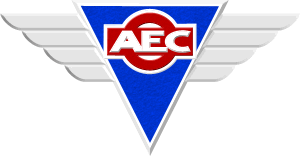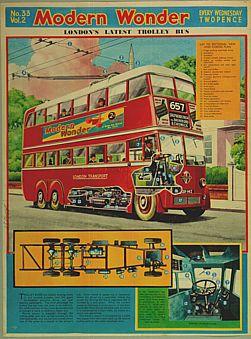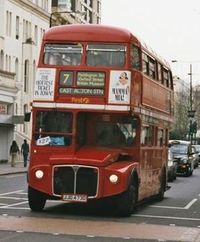  |
  |


AEC, or The Associated Equipment Company was founded in Walthamstow, London, in 1912. Their task primarily was to build buses for the London General Omnibus Company, although models were also sold to other buyers,AEC's first truck, the 3 - 4 ton Y-type, was built in 1916. Some 10,000 trucks were supplied, destined mainly for military use. Initially, engines were sourced from Daimler and Tylor, but in 1920 AEC started building its own engines.
1919 saw the introduction of the K-type, or 301, bus chassis intended for single or double deck bodies.
In 1922, AEC built 6 trolley-buses. Based on the S-type chassis, these used Dick Kerr traction equipment.

Image of a Trolley-bus, typical of the genre.
A trolley-bus is essentially a bus body (single-deck models were never as popular as double-deckers) with electric traction motors instead of engines. Power was conducted from the catenary (overhead power cables) via a pantograph mounted on the roof, to a huge rectifier. The driver controlled the amount of power to the traction motors.
Trams used the same technology, but ran on rails set into the ground.
During the 1920's, the truck range was expanded, with the 201 and 204 covering the 2.5 ton market, the 418 and 428 at 4 tons, and the 506, 507, and 508 at the 5 - 6 ton range. There was also an experimental artic, the 701.
AEC formed an alliance with Daimler in 1926, to sell trucks under the Associated Daimler Company (ADC) name, but the venture was not successful, and ADC ceased trading in 1928.
After ADC had dissolved, AEC continued to produce the old ADC423, with slight improvements, as the 426 and 427. 1928 also saw pneumatic tyres being offered as an option.
October of the same year saw Four Wheel Drive Motors Ltd and Hardy Rail Motors Ltd joining forces with AEC, in order to supply trucks using an amalgam of AEC components and Hardy chassis for all-wheel drive work.
As sales of AEC truck and buses increased, a move to a 63-acre site at Southall in Middlesex was taken. This improved output, and from 1930, all new models received names.
The 1930's saw other ranges being added to the line-up. The Matador was one of a range of trucks; Mercury was a 3.5-tonner, the Monarch was a 4-tonner, the Majestic was a 6-tonner, while the Mammoth was for 7-8 ton work. Matador was either a civilian 4x2, or a military 4x4, the Mammoth Major was a 12-ton 6-wheeler, and the Mammoth Major 8 was an 8-wheeled 15-tonner.
All vehicles used a range of engines, but primarily the same transmissions, axles and cabs. This, along with differing chassis lengths, allowed a much wider wider diversity of weights and configurations.
The double-decked A185 bus was developed in 1938 to replace the ageing Regent; this was ultimately to become known as the RT, the archetypal London bus. It was to remain in use until 1979.

AEC RT.
During the second World War, production became geared more towards military output, even to the extent of rejigging the Matador as a 4x4, 10-ton gun tractor. A further development of this was a civilian 6x6 model for crane work.
In 1948, when AEC took control of the Mausdlay Motor Company, and Crossley Motors Ltd, they formed a new holding company, ACV (Associated Commercial Vehicles).
Maudslay vehicles were phased out and replaced with AEC's by 1950.
AEC introduced a new, twin-steer Mustang in 1956, and in 1966 the six-wheeled Marshall arrived, both of which were developed from the Mercury.
At the heavier end, the 4x2 Mandator the 6x2 or 6x4 Mammoth Major 6, and the 8x2/8x4 Mammoth Major 8 models filled the model range. There was also a tractor unit version of the Mandator.
During the 1950's, AEC were able to open new plants in Spain, Portugal, Belgium, South America and South Africa.
AEC moved into the dump truck market in the late 1950's, and in 1961 absorbed Thornycroft.
Further into 1961, AEC teamed up with Dutch firm NV Autoindustrie Verheul to develop chassisless passenger bodies.
1962 saw Leyland Motors Ltd take control of AEC.
The introduction of the Ergomatic cab saw the ranges rationalised, as Leyland trucks were competing in the same markets.
AEC developed a new, V8 Diesel for 1970. This engine was rushed into production in an effort to stem the flow of foreign trucks to the UK, but there were a great many failures, due to inadequate testing. Although the engine was a failure, operators blamed the truck, and looked to the likes of Volvo, Scania, and DAF for their replacements.
AEC finally closed it's factory in 1979.
One legacy that AEC left was the chassis and Ergomatic cab were further developed for the new Leyland Marathon II.
Between 1961 and 1968, AEC operated plants in Australia and South Africa, developing models for their respective markets.
The AEC Kudu was the first of the South African built vehicles, but many other vehicles were simply imported as kits from the UK.
In 1931, AEC formed another alliance, this time with the English Electric Company. Lasting until 1938, English Electric produced the traction equipment for their joint trolley-buses.
Metropolitan-Cammell-Weyman Motor Bodies Ltd (MCW), Park Royal Vehicles Ltd and AEC, designed a range of chassisless buses suited to AEC running gear. A development of this became the Routemaster.

The AEC Routemaster.
| © RIYAN Productions |